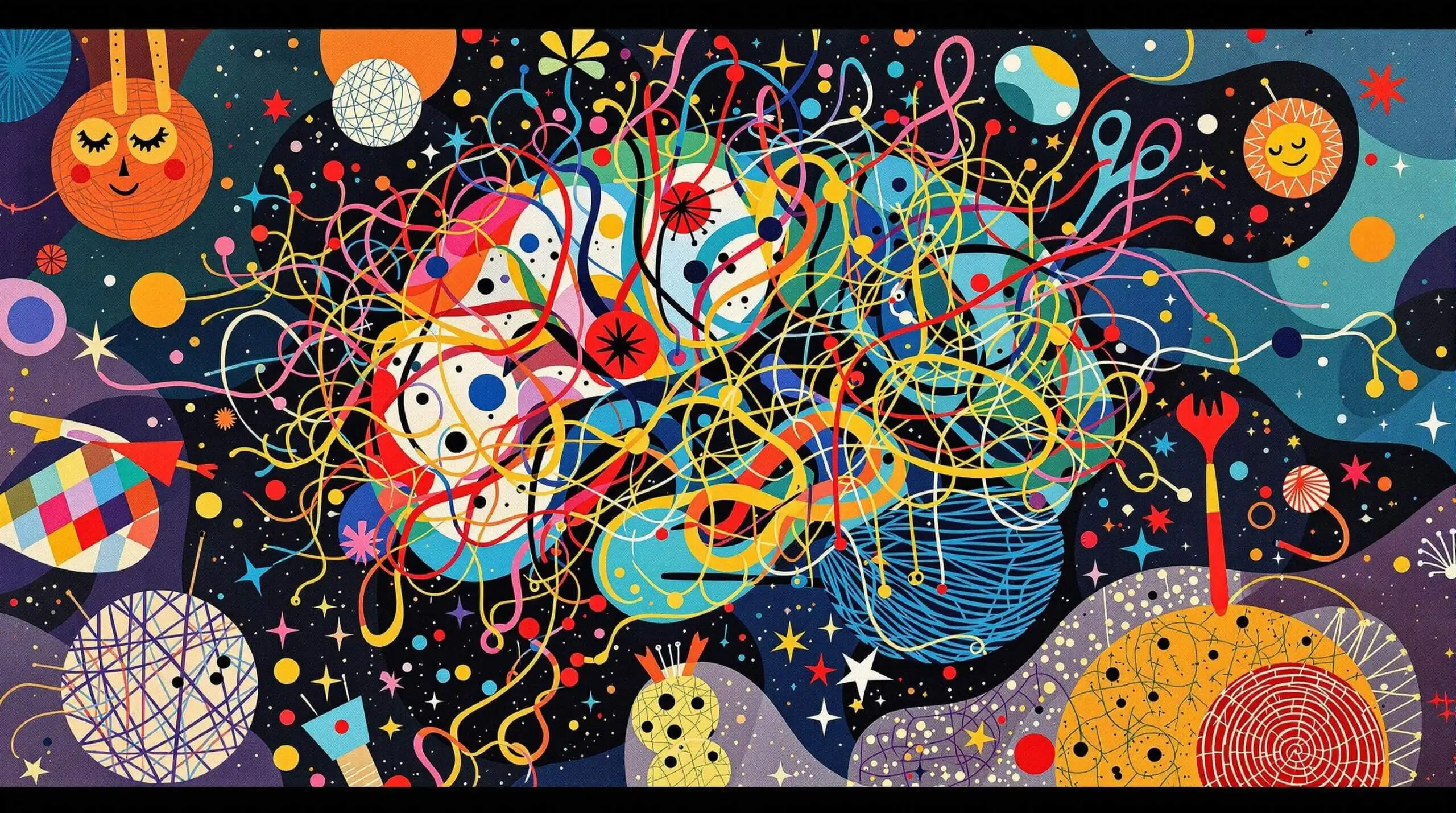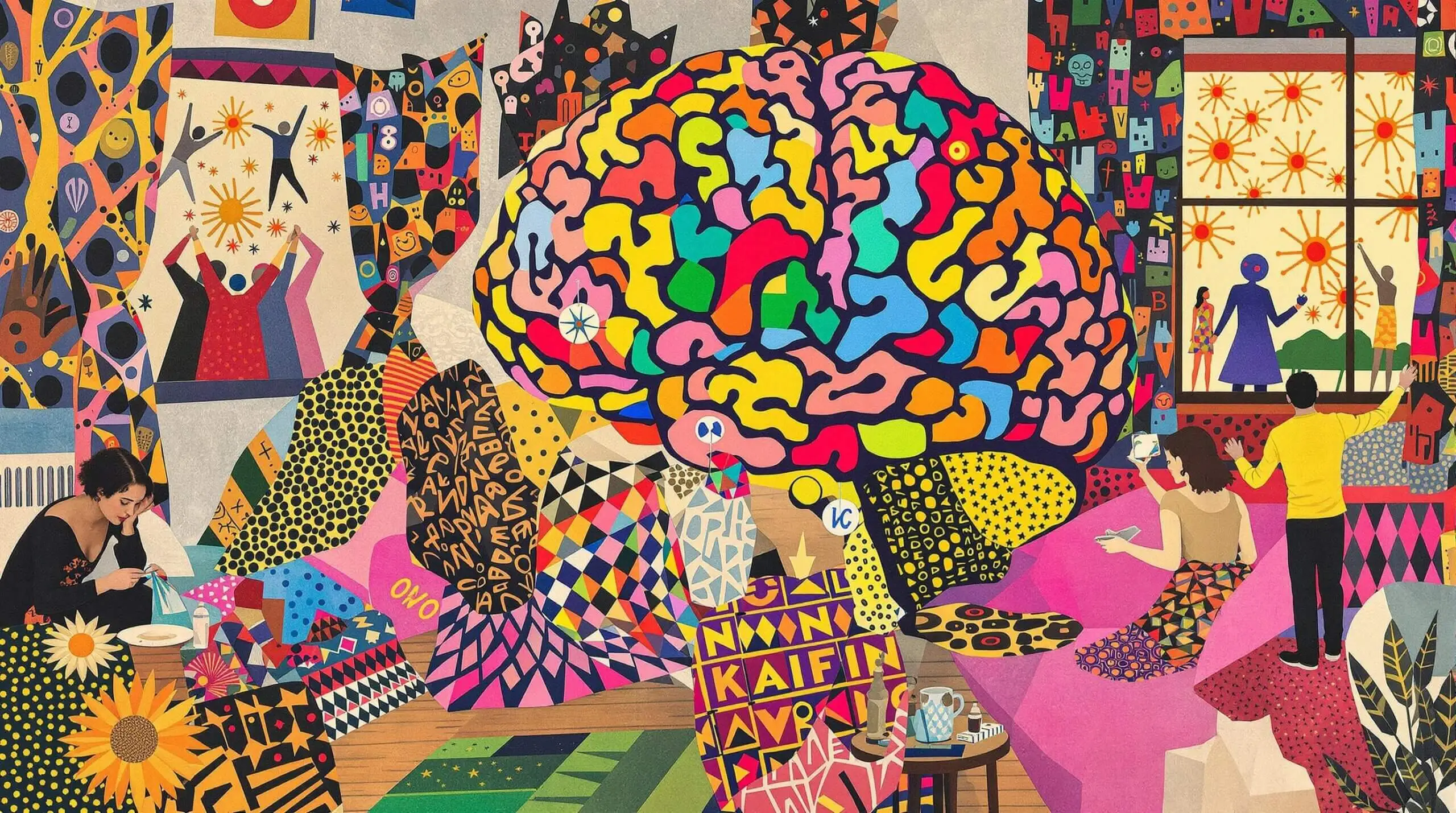Knitting for Neurons: Crafts That Boost Brain Health
Explore how engaging in knitting can enhance brain health and boost cognitive functions.

Understanding Brain Health and Creative Activities: The Basics
The Connection Between Crafting and Cognitive Function
Your grandmother was right all along – knitting isn’t just about creating cozy scarves. Research shows that crafting activities stimulate multiple brain regions simultaneously, creating new neural pathways and strengthening existing ones. It’s like sending your brain to the gym, but instead of lifting weights, you’re wielding knitting needles or a crochet hook.
The Science Behind Creative Activities and Brain Health
Crafting engages both hemispheres of the brain. The left hemisphere handles sequential processing and logic, while the right hemisphere manages spatial relationships and creativity. This dual activation creates a symphony of neural activity that supports cognitive health. Studies demonstrate that people who engage in crafts regularly have a 30-50% lower risk of developing mild cognitive impairment.
Historical Context and Modern Research
Ancient cultures understood the meditative benefits of handcrafts. The Egyptians wove intricate tapestries not just for decoration, but as a form of mental discipline. Modern neuroscience confirms these ancestral insights. A 2014 study published in the Journal of Neuropsychiatry found that activities like knitting and quilting reduced the risk of cognitive impairment by 40% in older adults.
Common Misconceptions About Brain Training
Many believe that brain health requires complex puzzles or expensive computer programs. However, research indicates that simple, repetitive crafting activities can be equally effective. The key isn’t the complexity of the task, but rather the combination of focus, creativity, and fine motor skills that crafting demands.
Statistical Evidence and Research Data
The numbers paint a compelling picture. Regular crafters show a 50% reduced risk of developing memory issues compared to non-crafters. Studies tracking older adults over five years found that those who engaged in creative activities at least twice weekly maintained better cognitive function. The combination of social crafting groups and creative work showed an additional 20% boost in cognitive benefits.

Current Understanding of Craft Therapy and Brain Health
Modern Applications of Craft Therapy
Healthcare providers now prescribe crafting as part of cognitive rehabilitation programs. The repetitive nature of knitting, for example, releases serotonin, reducing anxiety and depression while improving focus. Occupational therapists use craft activities to help stroke patients rebuild neural pathways and improve fine motor skills.
Different Crafts and Their Specific Benefits
Each craft offers unique cognitive advantages. Knitting improves working memory and attention span. Quilting enhances spatial awareness and pattern recognition. Drawing strengthens hand-eye coordination and visual processing. Pottery combines tactile stimulation with three-dimensional problem-solving. These activities create different neural pathways, building a more resilient brain.
The Mechanisms of Craft-Based Brain Enhancement
Neural Plasticity and Creative Activities
Brain plasticity – our brain’s ability to form new connections – thrives on novel experiences and challenges. Crafting provides exactly this type of stimulation. Learning new patterns, mastering techniques, and solving creative problems forces our brains to build fresh neural connections. This process is particularly vital as we age, helping maintain cognitive flexibility and mental sharpness.
The Role of Fine Motor Skills
Fine motor activities stimulate the cerebellum, which controls movement and balance but also plays a crucial role in attention and learning. The precise movements required in crafting strengthen these neural circuits. Research shows that people who regularly engage in fine motor activities maintain better dexterity and cognitive function as they age.
Emotional and Social Benefits
Crafting isn’t just about cognitive function – it’s also about emotional well-being. The satisfaction of creating something tangible releases dopamine, our reward neurotransmitter. Crafting in groups adds social interaction, another proven factor in maintaining brain health. Studies show that combining creative activities with social engagement provides a 63% greater benefit for cognitive function than either activity alone.
Key Crafts for Brain Health Enhancement
- Knitting and Crochet – Improves working memory and pattern recognition
- Drawing and Painting – Enhances visual processing and spatial awareness
- Quilting – Develops planning skills and geometric understanding
- Pottery – Strengthens hand-eye coordination and spatial reasoning
- Origami – Boosts concentration and mathematical thinking
- Woodworking – Improves problem-solving and planning abilities
- Jewelry Making – Enhances fine motor skills and attention to detail
- Weaving – Develops pattern recognition and sequential thinking
- Paper Crafting – Improves hand-eye coordination and creative planning
- Embroidery – Strengthens focus and visual discrimination
Practical Tips for Incorporating Crafts into Daily Life
- Start with simple projects to build confidence
- Set aside dedicated crafting time each day
- Join local crafting groups for social interaction
- Rotate between different crafts to challenge various cognitive skills
- Take classes to learn new techniques
- Share your creations with others to maintain motivation
- Create a dedicated crafting space at home
- Use online resources for inspiration and instruction
- Keep a craft journal to track progress
- Set achievable goals for project completion
Future Research and Implications
Current research is examining how different crafts affect specific brain regions and cognitive functions. Scientists are using advanced imaging techniques to map neural activity during creative tasks. Preliminary findings suggest that combining multiple craft types might provide the most comprehensive cognitive benefits.
New studies are also investigating the potential of craft therapy in treating neurodegenerative conditions. Early results indicate that structured crafting programs might slow cognitive decline in Alzheimer’s patients. Researchers are developing specialized craft-based interventions for different neurological conditions.
Getting Started with Brain-Boosting Crafts
- Choose crafts that interest you personally
- Invest in basic quality tools and materials
- Find a comfortable, well-lit workspace
- Start with beginner-friendly projects
- Join online communities for support and inspiration
- Set realistic time commitments
- Document your progress with photos
- Celebrate small achievements
- Be patient with the learning process
- Share your journey with friends and family
The evidence supporting crafting for brain health is substantial and growing. Regular engagement in creative activities provides measurable cognitive benefits, from improved memory to enhanced problem-solving skills. The combination of mental stimulation, fine motor activity, and emotional satisfaction makes crafting a powerful tool for maintaining brain health. Whether you’re a seasoned crafter or just beginning, incorporating these activities into your routine can contribute significantly to your cognitive well-being and overall quality of life.